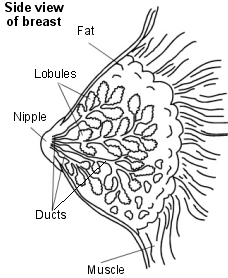Back Symptoms Explained
Breast Problems
We have selected the following expert medical opinion based on its clarity, reliability and accuracy. Credits: Sourced from the website Patient UK, authored by Dr Colin Tidy, reviewed by Dr Hannah Gronow (see below). Please refer to your own medical practitioner for a final perspective, assessment or evaluation.
Overview
Breast problems are very common in women of all ages. Most breast problems are not caused by breast cancer but it is really important to get any breast problems or concerns checked by a doctor. You may need to be referred to a breast specialist and you may need some tests such as a mammogram and ultrasound scan to find out the cause.
What breast problems can occur?
There are many different breast problems, including:
- Breast lumps
- Breast pain and tenderness
- Infection may cause hardness, pain, redness and swelling in the breast (mastitis)
- Nipple discharge
- Inverted nipples
- Changes in the skin of the breast
What is the structure of a normal breast?

Cross-section diagram of a breast, showing a normal breast
The breast is connected to muscles on the wall of your chest. It is made up of fatty tissue. Within the fatty tissue are lobules or milk-forming glands. Milk drains from these glands into breast ducts during breastfeeding. Milk then leaves the ducts through your nipple.
The glands and ducts can decrease or increase in number and size. This will depend on whether they are needed.
Breast lumps can involve any of these different tissues, or components, that make up your breast.
What are the causes of nipple discharge?
Nipple discharge is usually caused by benign disease (ie not breast cancer). Normal nipple discharge occurs during pregnancy and breastfeeding and may continue until up to one year after childbirth or the end of breastfeeding. Excessive breast stimulation can also cause nipple discharge.
Nipple discharge can be caused by certain gland (endocrine) problems such as a prolactinoma or if you're taking certain medicines (the combined oral contraceptive pill, cimetidine, antidepressants or metoclopramide).
Nipple discharge caused by an underlying breast problem (for example, breast cancer) is more likely to affect only one breast, the discharge may be bloodstained and there may also be an abnormal lump in the same breast.
What are the causes of inverted nipples?
An inverted nipple points into the breast instead of the normal shape of pointing outwards. Inverted nipples are often harmless with no serious underlying cause. Many women are born with nipples that naturally invert at times and then point outwards at other times. Sometimes the nipple may become inverted after breastfeeding.
If one or both nipples start to invert, then it is very important to get it checked out but most cases are not due to anything serious.
The possible causes of inverted nipples include:
- Injury to the breast, or breast surgery
- Breast Cancer
- Breast infections - for example, mastitis
- Rapid and substantial loss of weight
What are the causes of changes in the skin of the breast?
Skin problems can develop on or near the breast. There may be itching, scaling, dimpling, swelling, redness or other changes in skin colour. There is often no serious underlying breast problem but these skin changes may be caused by breast cancer so it's really important to get checked out straightaway in case there is a serious problem.
About the author
Dr Colin Tidy
MBBS, MRCGP, MRCP, DCH
Dr Colin Tidy qualified as a doctor in 1983 and he has been writing for Patient since 2004. Dr Tidy has 25 years’ experience as a General Practitioner. He now works as a GP in Oxfordshire, with a special interest in teaching doctors and nurses, as well as medical students. In addition to writing many leaflets and articles for Patient, Dr Tidy has also contributed to medical journals and written a number of educational articles for General Practitioner magazines.
Dr Hannah Gronow
MB ChB
Hannah qualified in 1997. She joined EMIS (patient.info) as a peer reviewer in August 2006. Currently a part time salaried GP in Paignton and moving to a practice in Brixham in 2018. Hannah is about to start a diploma in psychotherapy. Her interests include oncology and pharmacology.
_______________________________________________________________________________________________________________________
Are you a healthcare practitioner who enjoys patient education, interaction and communication?
If so, we invite you to criticise, contribute to or help improve our content. We find that many practicing doctors who regularly communicate with patients develop novel and often highly effective ways to convey complex medical information in a simplified, accurate and compassionate manner.
MedSquirrel is a shared knowledge, collective intelligence digital platform developed to share medical expertise between doctors and patients. We support collaboration, as opposed to competition, between all members of the healthcare profession and are striving towards the provision of peer reviewed, accurate and simplified medical information to patients. Please share your unique communication style, experience and insights with a wider audience of patients, as well as your colleagues, by contributing to our digital platform.
Your contribution will be credited to you and your name, practice and field of interest will be made visible to the world. (Contact us via the orange feed-back button on the right).
Disclaimer:
MedSquirrel is a shared knowledge, collective intelligence digital platform developed to share medical knowledge between doctors and patients. If you are a healthcare practitioner, we invite you to criticise, contribute or help improve our content. We support collaboration among all members of the healthcare profession since we strive for the provision of world-class, peer-reviewed, accurate and transparent medical information.
MedSquirrel should not be used for diagnosis, treatment or prescription. Always refer any questions about diagnosis, treatment or prescription to your Doctor.
